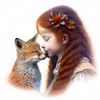Yellow-necked mouse
(Apodemus flavicollis)
Length from head to rump: 70 - 112 mm
Length of hind feet: 22.3 - 24.5 mm
Tail length: 77 - 120 mm
Weight: 26 - 36 g
Food:
Pollen and nectar from flowers, tree, cereal and grass seeds, fungi, but also berries, as animal food insects and larvae, earthworms, spiders, snails, small vertebrates (bats, young birds).
At up to 40 %, the proportion of animal food is highest in the fall.
For the winter, they stock up on hazelnuts, acorns or beechnuts.
Distribution:
Germany - not in the extreme NW and not on the North Frisian Islands
Habitat:
Mixed forests, especially deciduous forests (oak and beech forests) with a high proportion of fruit-bearing trees; is tied to wooded habitats; can also be found in hedges and gardens with trees
Enemies:
Pine martens, foxes, polecats, stoats, weasels, cats,
Owls (tawny owl, long-eared owl, barn owl, long-eared owl, eagle owl)
Life expectancy:
1 year (very high winter mortality)
Several years in captivity
The yellow-necked mouse is active at dusk and at night and is a very agile animal. It can run fast, jump far and climb effortlessly, often covering long distances by jumping.
Gelbhalsmaus
(Apodemus flavicollis)
Kopf-Rumpflänge: 70 - 112 mm
Länge der Hinterpfoten: 22,3 - 24,5 mm
Schwanzlänge: 77 - 120 mm
Gewicht: 26 - 36 g
Nahrung:
Pollen und Nektar von Blüten, Baum-, Getreide- und Grassamen, Pilze, aber auch Beeren, als tierische Nahrung Insekten und Larven, Regenwürmer, Spinnen, Schnecken, kleine Wirbeltiere (Fledermäuse, Jungvögel).
Mit bis zu 40 % ist der Anteil an tierischer Nahrung im Herbst am höchsten.
Für den Winter decken sie sich mit Haselnüssen, Eicheln oder Bucheckern ein.
Verbreitung:
Deutschland - nicht im äußersten NW und nicht auf den Nordfriesischen Inseln
Lebensraum:
Mischwälder, vor allem Laubwälder (Eichen- und Buchenwälder) mit hohem Anteil an fruchttragenden Bäumen; ist an Waldstandorte gebunden; kann auch in Hecken und Gärten mit Bäumen vorkommen
Feinde:
Baummarder, Füchse, Iltisse, Hermeline, Wiesel, Katzen,
Eulen (Waldkauz, Waldohreule, Schleiereule, Waldohreule, Uhu)
Lebenserwartung:
1 Jahr (sehr hohe Wintersterblichkeit)
Mehrere Jahre in Gefangenschaft
Die Gelbhalsmaus ist dämmerungs- und nachtaktiv und ein sehr flinkes Tier. Sie kann schnell laufen, weit springen und mühelos klettern, wobei sie oft weite Strecken im Sprung zurücklegt.

























Rainer Switala 19/09/2024 12:29
gute info zum mausblickgruß rainer
Mark Billiau. 18/09/2024 7:01
Well spotted and beautifully captured !Good focus on its eye !
Wolfgang Kaeding 17/09/2024 13:54
Hallo Babs,tolles Foto von dieser besonderen Maus.
Viele Grüße Wolfgang
Marina Luise 17/09/2024 11:54
Sie rühren einen so durch ihre großen blanken Äuglein!Elke Becker 17/09/2024 7:21
Ein wunderbares Portrait zeigst du von der süßen Maus, liebe Babs!Herzliche Grüße, Elke und dein Wuschel
Nneli 17/09/2024 5:01
Tolle Aufnahme und Infos! Hübsches Tier! VG Annelianne47 16/09/2024 23:42
Sie sieht wirklich süß aus mit ihren Knopfaugen und dem gelblichen Fell.Gut erwischt hast du sie.
LG Anne
Susann Kahlcke 16/09/2024 21:35
Wie niedlich.LG Susann
Maria Kohler 16/09/2024 20:50
Niedlich sieht das Mäuschen aus.Gut getroffen.
LG Maria
Dieter Paulus 16/09/2024 19:59
Sehr schön getroffen die keine MausFoto dunkel gehalten passt gut
Beste Grüße
Dieter
Hannelore AYDIN 16/09/2024 19:51
niedlich sind sie ja…nur diesen nackten Schwanz mag ich nicht …. Mit einer tollen Schärfe hast du ihn rein gestellt. Mit freundlichen Grüßen HanneloreWolfgang Weninger 16/09/2024 18:29
so bezaubernd, wenn sie nicht gerade im Haus anzutreffen sindServus, Wolfgang
Tukan620 - Tomasz Stepien 16/09/2024 17:39
Süß der Kleine.!!!LG. Tomasz
alicefairy 16/09/2024 17:32
allerliebst die KleineLg Alice